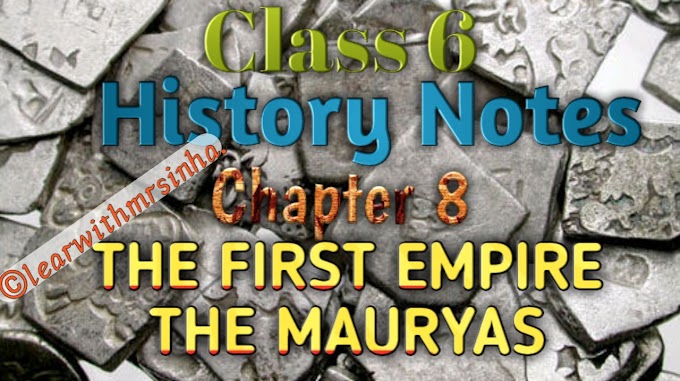Culture and Science in the Ancient Period
The Vedas and associated texts
· The Vedas are the earliest literary works that we have.
· Veda means knowledge
· There are four Vedas – Rig Veda, Yajur Veda, Sama Veda and Atharva Veda.
· They contain hymns in praise of different god and goddesses.
· Along with the Vedas, there are a series of texts called the Brahmanas. (Commentaries on the Vedas)
· Each Veda has a separate Brahmana.
· There are also 108 Upanishads. (The essence of Vedanta philosophy is contained in these Upanishads.
· Puranas (18) are sacred literature.
· The law books (Dharma Shastras) are also a part of ancient Indian literature.
· The Buddhist and Jain texts also from a part of Indian literature.
· The Jataka Tales – stories about the previous births of Lord Buddha.
Class 6 History Notes Chapter 12
The Epics
· The Mahabharata was composed by Sage Ved Vyasa.
· It is the story of two sets of cousins – The Kauravas and the Pandavas.
· Mahabharata also includes the Bhagavad Gita. It is the conversation between Lord Krishna and Arjuna on the battlefield.
· The Ramayana was composed by Sage Valmiki.
· It is the story of Rama, a prince of Kosala (capital was Ayodhya) and his war with Ravana (the king of Lanka).
Secular Literature
· The Arthashastra, Indika, Harshacharita, Stories from the Jatakas and the Panchatantra, the works of Kalidasa and the accounts of foreign travelers are the important secular works of this period.
· The Arthashstra (political system of the time and the art of governance of Mauryas)and Indika (Political, Social and economic conditions during the Mauryan Dynasty)were written by Kautilya and Megasthenes respectively.
· Harshcharita (description of the early life of Harshavardhana)written by Banabhatta.
·
Kalidasa (One of the greatest poet
and dramatists) lived during the reign of the Gupta kings. His famous works:- Meghaduta,
Raghuvamsha, Ritusamhara, Abhijnanashakuntalam and Kumarasambhava.
ART AND ARCHITECTURE
Stupas :- The Great Stupa at Sanchi, The Dhamek Stupa at Sarnath, Stupas at Amaravati (Andhra Pradesh), Stupa at Bharhut.
Sculptures :- Lion Capital from the pillar at Sarnath, Chaitya at Karli (near Pune), Viharas or the monasteries (places where Buddhist monks lived)
Seated Buddha (stone sculpture) Sarnath
“
The art of sculpture developed further with the growth of the Gangdhara and
the Mathura schools of art.”
Descent of the Ganga or Arjuna’s Penance (Sculpture caved on rock) at Mahabalipuram
Temples :- The Cave temples at Ajanta, The Dasavatara Temple at Deogarh (near Jhansi), The temple at Bhitargaon (near Kanpur), The temple at Sanchi.
The Ratha Temple and the Shore Temple at Mahabalipuram and the Kailasanath Temple at Kanchi were built by the Pallavas.
Common Structure of temples constructed during this period :-
· Grabhagriha – It was the room where the image of the chief deity was kept.
· Shikhara or Vimana – It was a tower on top of the garbhagriha to mark it out as a sacred place.
· Mandapa – It was an assembly hall where people assembled and prayed.
Painting
· The history of painting in India goes back to the Old Stone Age. (Bhimbetka)
· During the Gupta period, the walls of the cave monasteries at Ajanta were decorated with beautiful paintings, called ‘murals’.(depict events from the life of the Buddha)
· Science was advance in ancient India. The town planning of the Indus cities was based on scientific principles.
·
Knowledge of medicine improved, largely due to
the efforts of Charaka and Sushruta.
·
Charaka wrote the Charaka Samhita and
Sushruta was a specialist in cosmetic surgery.
·
Dhanvantari was a general
physician.
·
Romaka Siddhanta is an important
work on astronomy.
·
Aryabhata and Varahamihira were well-known mathematicians and
astronomers.
·
Aryabhata wrote a book called Aryabhatiyam
in Sanskrit (About Earth’s movement). He found a mathematical method of
calculating the circumference of a circle.
·
Varahamihira wrote an Brihat Samhita. (an
encyclopedia of science)
The Iron Pillar at
Mehrauli, in Delhi, is a proof of the skill of the Indian craftsmen. It was
constructed over 1,600 years ago, during the reign of the Guptas. The pillar is
made of iron. It is 7.2 metres high and weighs around 6.5 tonnes. It is known
as the ‘rustless wonder’ because despite being exposed to the sun and rain for
all these centuries, it has not rusted.
*****
· It-Sing was another Chinese traveler to come to India.
· Sangam Texts mentions the kingdoms of South India.
· The Silappadikaram and the Manimekalai are the famous Tamil epics.
· Ancient Indian religious literature includes the four Vedas, The Brahmanas, the Upanishads, the Puranas and the Mahabharata and Ramayana. The secular literature includes the Arthashastra, Indika, Harshacharita, works of Kalidasa, the accounts of foreign travelers and the Sangam literature.
· The architecture of the period includes a large number of stupas, chaityas, viharas and temples.
· Sculpture was both religious and secular. Gandhara and Mathura were famous centres of sculpture.
· Many Stone age paintings have been found in India. The walls of the monasteries at Ajanta and decorated with beautiful paintings.
· All branches of science progressed. Charaka and Sushruta were experts in medicine. Aryabhata and Varahamihira were famous mathematicians and astronomers. The Iron Pillar is a masterpiece.







0 Comments